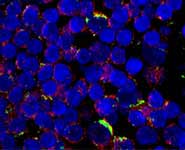The research team, led by Professor Paolo Madeddu, Chair of Experimental Cardiovascular Medicine in the School of Clinical Sciences and Bristol Heart Institute at the University of Bristol, investigated the effect of diabetes on bone marrow stem cells and the nurturing of small blood vessels in humans.
The new study, published in the American Heart Association journal Circulation Research, was funded by the British Heart Foundation (BHF).
The researchers have shown a profound remodelling of the marrow, which shows shortage of stem cells and surrounding vessels mainly replaced by fat, especially in patients with a critical lack of blood supply to a tissue (ischaemia). This means that, as peripheral vascular complications progress, more damage occurs in the marrow. In a vicious cycle, depletion of bone marrow stem cells worsens the consequences of peripheral ischaemia.
Investigation of underpinning mechanisms revealed that exposure of bone marrow stem cells to the high glucose level typical of diabetes mellitus impacts on “microRNAs”, which are tiny RNA molecules controlling gene expression and hence biological functions. In particular, microRNA-155, that normally controls the production of stem cells, becomes dramatically reduced in bone marrow cells exposed to high glucose. Diabetes-induced deficits are corrected by reintroducing microRNA-155 in human stem cells. The authors foresee that microRNAs could be used to regain proper stem cells number in diabetes and fix stem cells before reintroduction into a patient's body.
Professor Paolo Madeddu said: “Our study draws attention to the bone marrow as a primary target of diabetes-induced damage. The research suggests that the severity of systemic vascular disease has an impact on bone marrow causing a precocious senescence of stem cells. More severe bone marrow pathologies can cause, or contribute to, cardiovascular disease and lead to worse outcomes after a heart attack, through the shortage of vascular regenerative cells. Clinical evidence indicates that achieving a good control of glucose levels is fundamental to prevent vascular complications, but is less effective in correcting microangiopathy. We need to work hard to find new therapies for mending damaged microvessels.”
Professor Costanza Emanueli, Chair of Vascular Pathology and Regeneration at the University of Bristol and co-author of the paper, added: “MicroRNAs represent an attractive means to repair the marrow damage and generate “better” stem cells for regenerative medicine applications. We are working at protocols using microRNA targeting for enhancing the therapeutic potential of stem cells before their transplantation to cure heart and limb ischaemia, which are often associated with diabetes mellitus. More work is, however, necessary before using this strategy in patients.”
The findings advance the current understanding of pathological mechanisms leading to collapse of the vascular niche and reduced availability of regenerative cells. The data provides a key for interpretation of diabetes-associated defect in stem cell mobilisation following a heart attack. In addition, the research reveals a new molecular mechanism that could in the future become the target of specific treatments to alleviate vascular complications in patients with diabetes.
Professor Jeremy Pearson, Associate Medical Director at the BHF said: “Professor Madeddu and his team have shown for the first time that the bone marrow in patients with diabetes can’t release stem cells which are important for the repair of blood vessel damage commonly found in people with the disease.
“If we could restore the ability of the marrow to release stem cells there is potential to reduce the effects of diabetes, and prevent the devastating consequences of the condition such as blindness and amputation. Understanding more about injured blood vessel repair will also aid in the fight to mend hearts damaged after a heart attack, a vital research area we fund through our Mending Broken Hearts Appeal.’
Paper: Global Remodeling of the Vascular Stem Cell Niche in Bone Marrow of Diabetic Patients: Implication of the miR-155/FOXO3a Signaling Pathway, Gaia Spinetti, Daniela Cordella, Orazio Fortunato, Elena Sangalli, Sergio P. Losa, Ambra Gotti, Franco Carnelli, Francesco Rosa, Stefano Riboldi, Fausto Sessa, Elisa Avolio, Antonio Paolo Beltrami, Costanza Emanueli, and Paolo Madeddu, Circulation Research, originally published online December 18, 2012.
